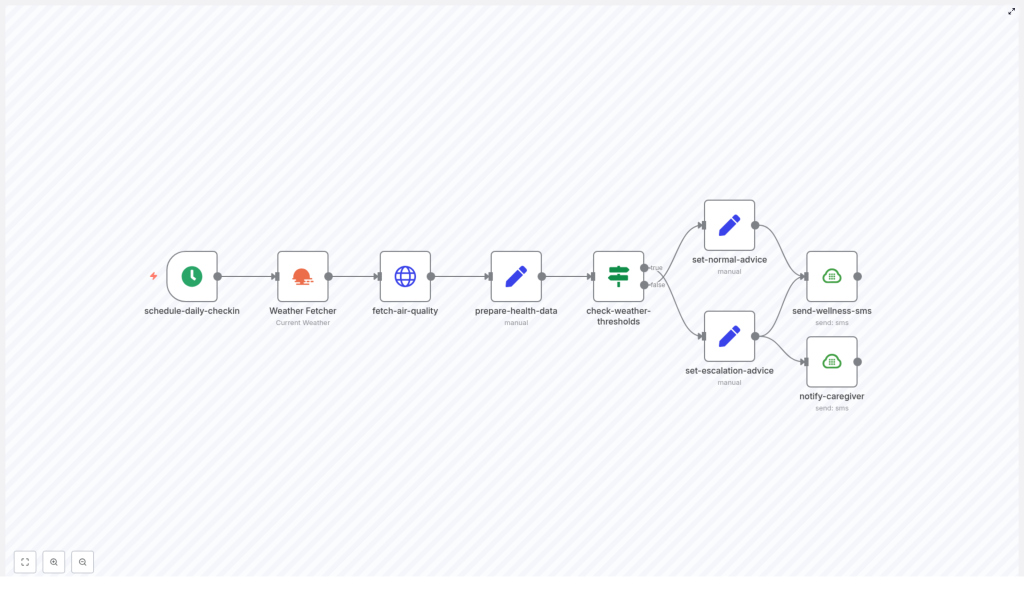Elderly Care: Daily Wellness & Weather Alerts
This guide walks you through a practical, automated workflow that performs daily wellness check-ins for elderly family members, pulls local weather and air quality data, and sends tailored SMS alerts to the senior and a caregiver when conditions require escalation. The solution uses a low-code automation platform pattern and common APIs to keep seniors safe and caregivers informed.
Why automate daily wellness and weather alerts?
Older adults are more sensitive to environmental extremes — heat, cold, high winds, and poor air quality — which can trigger health events. Automating a daily wellness check-in tied to local weather and air quality provides:
- Consistency: A scheduled, reliable touchpoint every morning.
- Proactive care: Early warnings for extreme weather conditions.
- Reduced caregiver burden: Automatic escalation only when needed.
- Data-driven advice: Simple, actionable recommendations (e.g., stay hydrated, avoid outdoor activity).
Solution overview and key components
The workflow implemented in the example uses these primary components:
- Scheduler (cron) — triggers the workflow at a set time each day.
- Weather API (OpenWeatherMap) — retrieves current temperature, feels-like, humidity, and wind data.
- Air quality API — fetches local AQI to identify unhealthy pollution levels.
- Data preparation node — maps API responses into normalized fields (temperature, windSpeed, airQualityIndex, feelsLike, humidity).
- Decision node (If/Condition) — evaluates thresholds for temperature, humidity, wind, and AQI to determine if escalation is required.
- Messaging gateways (e.g., Plivo, Twilio) — send SMS notifications to the senior (wellness message) and caregiver (escalation alert).
How the workflow works (step-by-step)
1. Schedule daily check-in
Set a cron node to run the workflow every morning (for example, 08:00 local time). Consistent timing ensures the senior receives the wellness message before leaving the house or starting their day.
2. Fetch weather and air quality
Call the weather provider to get current conditions for the recipient’s city or coordinates. Then request air quality data (AQI) using the coordinates returned by the weather API. Example API calls:
// Pseudocode for OpenWeatherMap current weather call
https://api.openweathermap.org/data/2.5/weather?q=Miami&appid=YOUR_API_KEY&units=metric
// Air Pollution API using coordinates
https://api.openweathermap.org/data/2.5/air_pollution?lat={lat}&lon={lon}&appid=YOUR_API_KEY
3. Normalize and prepare data
Extract and map the important fields into easy-to-reference variables:
- temperature: main.temp
- feelsLike: main.feels_like
- windSpeed: wind.speed
- humidity: main.humidity
- airQualityIndex: list[0].main.aqi
Keeping names simple helps when creating conditions and message templates.
4. Evaluate thresholds for escalation
Define clear, clinically-informed thresholds for escalation. Example thresholds used in the workflow:
- temperature < 0°C (risk of hypothermia)
- temperature > 32°C (risk of heat-related illness)
- feelsLike > 38°C (extreme heat)
- windSpeed > 15 m/s (dangerous winds)
- airQualityIndex indicates unhealthy levels (AQI 3–5 depending on provider)
Use an If node to evaluate these rules with a logical OR combinator so any single extreme condition triggers escalation.
5. Send tailored messages
If conditions are within normal range, send a friendly wellness SMS to the senior with suggestions to enjoy the day safely. If any threshold is exceeded, send a clear, urgent SMS to the senior and an escalation SMS to the caregiver.
Example message templates (templating uses the platform’s expressions):
Wellness SMS:
"Good morning! Temp: {{temperature}}°C. Advice: {{healthAdvice}}"
Escalation SMS (caregiver):
"ALERT: Extreme conditions detected for [Name]. Temp: {{temperature}}°C. {{healthAdvice}} Please check on them immediately."
Example expressions used in the workflow
Here are example expression templates you can copy into the automation platform’s Set nodes or message fields:
// Assignments in a Set node
{ "temperature": "={{$node['Weather Fetcher'].json.main.temp}}",
"windSpeed": "={{$node['Weather Fetcher'].json.wind.speed}}",
"airQualityIndex": "={{$json.list[0].main.aqi}}",
"feelsLike": "={{$node['Weather Fetcher'].json.main.feels_like}}",
"humidity": "={{$node['Weather Fetcher'].json.main.humidity}}" }
// Conditional check (If node) - pseudocode
temperature < 0 OR temperature > 32 OR windSpeed > 15 OR feelsLike > 38
Best practices and considerations
1. Choose sensible thresholds
Customize thresholds based on the senior’s health profile and local climate. What counts as “extreme” in one region may be normal in another.
2. Localize units and language
Support metric and imperial units and ensure messages are in the recipient’s preferred language for clarity.
3. Privacy and security
Treat personal and location data with care. Use secure API keys, protect phone numbers, and limit logging of sensitive health or identity data.
4. Testing and safe rollouts
Test the workflow with your own phone numbers and sample data before enabling automatic messages to vulnerable recipients. Include a “dry-run” mode that logs actions without sending messages.
5. Rate limits and API costs
Monitor API usage for weather and AQi services. Use caching for identical requests to avoid unnecessary calls and costs.
Troubleshooting tips
- Missing coordinates: Ensure the weather API returns coordinates before calling the air pollution endpoint.
- Incorrect units: Verify the units parameter (metric vs imperial) on weather requests.
- SMS delivery failures: Check messaging service credentials and confirm carrier support for the destination country.
Extending the workflow
This automation can be extended in several useful ways:
- Integrate wearable or home sensor data (heart rate, motion) for richer context.
- Add a daily two-way SMS check asking the senior to confirm they’re okay; use replies to trigger additional actions.
- Log daily conditions and messages to a spreadsheet or database for trend analysis and auditing.
- Use voice call fallback for critical alerts if SMS delivery fails.
Conclusion
Automating daily wellness check-ins tied to weather and air quality gives caregivers a scalable, practical tool to proactively protect older adults. With a scheduled trigger, reliable weather and AQI data, clear escalation rules, and SMS notifications, you can deliver consistent daily care while reserving manual intervention for when it truly matters.
Ready to implement this workflow? Set up your scheduler, connect your weather and air-quality APIs, and configure messaging credentials. Test thoroughly and tailor thresholds to the senior’s needs.
Call to action: Try building this workflow in your automation platform today — and if you need help customizing it for a specific senior care scenario, reach out for a consultation or share your questions below.

